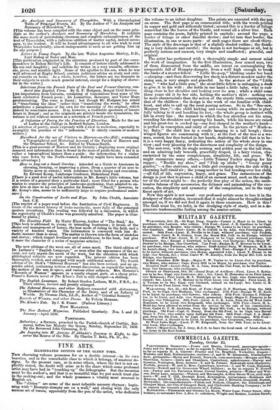FINE ARTS,
ILLUSTRATED DITTIES OF THE OLDEN TIME.
Tuft charming volume possesses for us a double interest—in its own beauties, and in the remarkable class to which it belongs, of amateur de- s. In the present case, as in some others, where the fact is not ex- p 'qtly stated, the doubt will arise as to the share which some professed artist may have had in "touching up" the lithographs. But the invention Must be the author's, and that is so beautiful that we put much trust also in the making-out; and the whole possesses a vitality most unusual in English art.
The "ditties " are some of the most infantile nursery rhymes ; begin- ning with " Humpty-dumpty sat on a wall," and closing with the only serious set of verses, apparently from the pen of the artist, who dedicates the volume to an infant daughter. The prints are executed with the pen on stone. The first page is an ornamented title, with the words printed in copper and gold and delicately tinted ; around this is a border of foliage somewhat like the leaves of the thistle, and round all a silver line Each page contains the poem, lightly printed in capitals; around the page, a border of foliage or other fanciful device ; and let into that border, the illustration, in one or more parts : of such pages there are about thirty. The style of the drawings is that of a slightly shaded outline; the finish- ing is very delicate and careful ; the design is not burlesque at all, but is perfectly serious and earnest, very simple and unaffected ; graceful, and The artist has performed with a thoroughly simple and earnest mind the work of imagination. In the first illustration, four armed men, two of them dismounted from the saddle, are intent on contemplating the irreparable fall of Humpty-dumpty, from a wall high enough to break the limbs of a stouter fellow. " Little Bo-peep," blinking under her hand —sleeping--and then discovering her sheep in a distant meadow under the rising sun, is very simple and graceful. In the picture of the "Little man," " who had a little gun," the stout little fellow is nnbagging a duck to give it to his wife : she holds in one hand a little baby, who is cud- dling close to her shoulder and looking over its arm ; while a child some three years old is by her side, holding the mother's skirt : nothing can be more characteristic than the action of the sturdy little countryman, or that of the children : the design is the work of one familiar with child- hood, and able to call up the most passing actions. So in the "See-saw, Margery Daw,"--the child kicking and cooing while its mother is play- fully talking to it and handling its feet, —the whole group is instinct with life in every line : the manner in which the boy stretches out his arms, rounding his shoulders and opening his hands, while his knees are raised and his great-toe is cocked up—one foot clasped in the mother's hand- le perfect in conception and unity of action. In the picture of " Hush-a- by, Baby," the child lies in a cradle hanging to a tall bough ; three winged figures are communing with it ; at the foot of the tree is a ems man, seated, her face buried in her hands, deploring the fall that is to be : it is a very happy fancy, indicating the action of the whole story in one view ; and very pleasing for the directness and simplicity of the design. The nut-tree, with its single nutmeg and golden pear on the tall stem, and an admiring lady beneath, gracefully draped, is a fairy vision, cha- racterized by the same completeness, simplicity, life, and grace. We might enumerate many others,—Little Tommy Tucker singing for his supper ; " Buckle my shoe," and* "Pick up sticks " ; " Goosy goosy gander,"—a fine staircase, and a little girl creeping down the side with a charming half-timid air ; the young motherin bed bending over her child, —all full of life, expression, fancy, and grace. The earnestness of the design is just that to please a child of an earnest mind, such as the daugh- ter of the artist might be : the perfectly free play of the action, the unob- trusive fulness of the accessories, the delicacy and painstaking of the exe- cution, the simplicity and symmetry of the composition, are in the very finest spirit of art.
Now this spirit is not usual: our professed artists seem to lose it in the drudgery of their studies, insomuch that it might almost be thought extinct amongst us, if we did not find it again in these amateurs. How is this ? The fault must lie, we infer, in the drudging style of study, and in a de- generate tradesmanlike feeling among the master-artists.


























 Previous page
Previous page